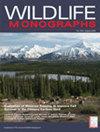白尾鹿鹿角限制采收制度的生物学和社会效益
摘要
选择性采收标准,如鹿角限制(APRs),已被用于调节雄性有蹄类动物的采收;然而,缺乏对这一管理战略的生物和社会反应的综合评价。2002年,宾夕法尼亚州通过了新的白尾鹿(Odocoileus virginianus)的APRs,根据野生动物管理单位的不同,要求合法收获的鹿角≥3或≥4分。历史上,亚成年(1.5岁)和成年(≥2.5岁)鹿角雄鹿的平均采收率为0.80。设计鹿角点限制是为了保护≥50%的亚成年雄鹿不被捕杀。大多数成年雄性仍然是合法的。在2002-2005年期间,我们估计了2个野生动物管理单位(Armstrong县和Centre县)无线电项圈公鹿(453只亚成年鹿,103只成年鹿)的收获率、存活率和原因特异性死亡率,以评估APRs增加成年公鹿招募的生物学效果。在相同的3年中,我们在每个狩猎季节前后进行了全州范围内的猎鹿人调查,以评估猎人对APRs的态度。我们进行了两种类型的调查:每次调查的所有许可证购买者的简单随机样本和完成所有6项调查的猎人纵向小组。在实施禁猎区的同时,宾夕法尼亚州狩猎委员会(PGC)增加了无角鹿的收成,以减少鹿的密度,以实现鹿的管理目标。生存率随月份和年龄的不同而不同,但在研究区域之间或实施APRs后的年份之间没有差异。亚成虫月存活率在狩猎季节为0.64 ~ 0.97,非狩猎期为0.95 ~ 0.99。亚成虫的年生存率为0.46 (95% CI = 0.41-0.52)。狩猎季节成虫月存活率为0.36 ~ 0.95,非狩猎期无死亡。成人年生存率为0.28 (95% CI = 0.22-0.35)。鹿角点限制成功地将亚成年鹿的采伐率降低到0.31 (95% CI = 0.23-0.38),约92%的这些鹿存活到下一个狩猎季节。除狩猎季节外,车辆碰撞是亚成虫和成虫死亡的最大原因。此外,我们观察到成年人的采伐率下降(0.59,95% CI = 0.40-0.72),尽管几乎所有的成年人都是合法采伐的。在带无线电项圈的亚成体中,6-11%的捕获鹿角是非法的,这表明猎人通常遵守了APRs。总体而言,在全州和我们的研究区域,鹿角的收获量下降,部分原因是由于保护区,但也因为无鹿角的收获量增加,使全州鹿群从2000年的149万头减少到2005年的114万头。然而,在2000年至2005年期间,阿姆斯特朗县成年雄性的收获量增加了976只(112%),中心县减少了29只(- 3%),而在全州范围内增加了14285只(29%),因为更多的雄性存活到3岁和4岁年龄段。来自随机抽样调查的猎人支持全州apr的比例在0.61 (95% CI = 0.59-0.64)和0.70 (95% CI = 0.66-0.73)之间变化。纵向专家组中支持保护区的猎人比例没有随着猎人在新条例下获得经验而增加;0.23人更支持,0.29人不支持,0.48人在3年后的同意水平不变。尽管在整个研究过程中有50%的猎人支持APRs,但对PGC鹿管理计划的支持有所下降;三年后,41%的纵向猎人对鹿管理计划的评价降低了,21%的人评价更高。我们认为APRs在生物学上是成功的,因为降低了亚成虫的采收率,增加了鹿角较大的成年雄鹿的采收。同样,由于大多数猎人在整个研究过程中都支持APRs,我们认为APRs在社会上是成功的。然而,我们预测在猎人经历了APRs的生物学结果后,APRs将越来越受欢迎,但支持的变化不大。我们认为猎人对apr的影响形成了初步印象,额外的经验和信息未能改变他们的看法。此外,为了适应种群中更多的雄性和满足机构的鹿种群目标,同时减少了鹿的总体密度,这可能进一步减少了对保护区的支持。我们发现,在宾夕法尼亚州实施的APRs是可执行的,猎人遵守,并成功地招募了更多的鹿角雄鹿到老年班级。为了促进社会对这些法规变化的接受,我们发现在这些变化实施之前获得支持可能很重要,因为大多数猎人在新法规实施3年后并没有改变他们对apr的看法。©2017野生动物协会。Selective harvest criteria, such as antler point restrictions (APRs), have been used to regulate harvest of male ungulates; however, comprehensive evaluation of the biological and social responses to this management strategy is lacking. In 2002, Pennsylvania adopted new APRs for white-tailed deer (Odocoileus virginianus) that required, depending on wildlife management unit, ≥3 or ≥4 points on 1 antler for legal harvest. Historically, harvest rates of subadult (1.5 yr old) and adult (≥2.5 yr old) antlered males averaged 0.80. Antler point restrictions were designed to protect ≥50% of subadult males from harvest. Most adult males remained legal for harvest. We estimated harvest rates, survival rates, and cause-specific mortality of radio-collared male deer (453 subadults, 103 adults) in 2 wildlife management units (Armstrong and Centre counties) to evaluate biological efficacy of APRs to increase recruitment of adult males during 2002–2005. We administered statewide deer hunter surveys before and after each hunting season over the same 3 years to evaluate hunter attitudes toward APRs. We conducted 2 types of surveys: a simple random sample of all license buyers for each survey and a longitudinal panel of hunters who completed all 6 surveys. At the same time APRs were implemented, the Pennsylvania Game Commission (PGC) increased antlerless harvests to reduce deer density to meet deer management goals.
Survival rates varied by month and age but not between study areas or among years after implementation of APRs. Monthly survival rates for subadults ranged from 0.64 to 0.97 during hunting seasons and 0.95 to 0.99 during the non-hunting period. Annual survival of subadults was 0.46 (95% CI = 0.41–0.52). Adult monthly survival rates ranged from 0.36 to 0.95 during hunting seasons and we had no mortalities during the non-hunting period. Annual survival of adults was 0.28 (95% CI = 0.22–0.35). Antler point restrictions successfully reduced harvest rate for subadults to 0.31 (95% CI = 0.23–0.38), and approximately 92% of these deer survived to the following hunting season. Vehicle collisions were the greatest source of mortality outside the hunting season for subadults and adults. Also, we observed decreased harvest rates for adults (0.59, 95% CI = 0.40–0.72), although nearly all were legal for harvest. Of radio-collared subadults, 6–11% were harvested with sub-legal antlers, indicating hunters generally complied with APRs. Overall, antlered harvest declined statewide and in our study areas, in part because of APRs but also because of increased antlerless harvests that reduced the statewide population from 1.49 million deer in 2000 to 1.14 million deer in 2005. However, between 2000 and 2005, harvest of adult males increased by 976 (112%) in Armstrong County, decreased by 29 (−3%) in Centre County, and increased by 14,285 (29%) statewide because more males survived to the 3- and 4-year-old age classes.
Proportion of hunters from the random sample surveys who supported statewide APRs varied among years between 0.61 (95% CI = 0.59–0.64) and 0.70 (95% CI = 0.66–0.73). The proportion of hunters from the longitudinal panel who supported APRs did not increase as hunters gained experience under the new regulations; 0.23 were more supportive, 0.29 were less supportive, and 0.48 were unchanged in their level of agreement after 3 years. Although >50% of hunters supported APRs throughout the study, support for the PGC's deer management program declined; 41% of the longitudinal panel of hunters rated the deer management program lower after 3 years and 21% rated it higher.
We considered APRs biologically successful because of decreased subadult harvest rates and increased harvest of adult males with larger antlers. Likewise, because the majority of hunters supported APRs throughout the study, we considered APRs socially successful. However, we predicted APRs would become increasingly popular after hunters experienced biological results of APRs, but there was little change in support. We believe hunters formed an initial impression of the effects of APRs, and additional experience and information failed to change their opinion. Furthermore, the concurrent reduction in overall deer densities to accommodate more males in the population and to meet agency deer population goals likely further reduced support for APRs. We found APRs as implemented in Pennsylvania to be enforceable, adhered to by hunters, and successful in recruiting more antlered males to older age classes. To facilitate social acceptance of these regulation changes, we found that obtaining support before the changes were implemented may have been important because most hunters did not change their opinions about APRs after 3 years of experience with the new regulations. © 2017 The Wildlife Society.

 求助内容:
求助内容: 应助结果提醒方式:
应助结果提醒方式:


